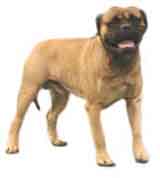Big DogsInformation About The Bullmastiff Dog Breed |
|
|
History and origin : The Bullmastiff is believed to have been evolved between 200 or 300 years ago by crossing the Mastiff with the Bulldog. He was used as a guard dog against poachers (who were hunting on large estates) without actually harming them. The Bullmastiff was bred to be courageous, quick, strong, and willing to challenge humans. Description : The Bullmastiff stands 24 to 27 inches at the shoulder and weighs between 100 and 135 pounds. He has a powerful, heavily muscled and boned body and a short, low-maintenance shedding coat that needs regular brushing. Ears may be cropped or uncropped. The color may be fawn, reddish brown, or brindle; a small white patch on the chest is acceptable. About the breed : The Bullmastiff is a trustworthy, affectionate, lazy, powerful breed with a natural instinct of guarding his home and family. These dogs are usually very suspicious of strangers and other dogs and are one of the most territorial of breeds. Though normally gentle with children in their own family, Bullmastiffs can be unpredictable with friends, relatives, and co-workers. Keep in mind that this breed was designed to challenge human beings and will do so without hesitation if a threat is perceived. When a Bullmastiff becomes aggressive, it is explosive and unstoppable. This breed is capable of killing another dog in seconds, so do not consider letting him off leash. The only way to minimize this instinctive behavior is to socialize and train the dog from day one, allowing the Bullmastiff puppy to interact with people and dogs in a controlled, positive environment. Males should be neutered by the eighth month. Females tend to be less aggressive and are quite more timid than males. The Bullmastiff is normally content to lie around the house. Though less energetic than the Boxer, he does tend to be slightly more active than the Mastiff. Training should begin early and should be firm but not overbearing, as this breed matures slowly and can become worried if pushed too hard. Patience and consistency are required, as well as positive, confident attitude. Spoiling will create a pushy dog that lacks confidence, a combination that could be dangerous. Mature children are permissible provided absolutely no roughhousing is permitted. This breed eats large quantities of food. He usually lives ten to twelve years, and is susceptible to bloat, hip dysplasia, eyelid abnormalities, gastrointestinal disorders, and respiratory problems. He snores and drools and is often flatulent.Feeding : Recommended feeding for this breed is at least 2 ½ cans (13.3oz) of a branded meaty product with biscuit added in equal amount or 5 cupfuls of a dry, complete food. Ideal home : A large house in the country with a fenced yard or kennel is preferred, though this breed is easygoing in the home. The owner of a Bullmastiff must be a strong, easygoing, confident leader who is fully aware of the power of this breed and who does not project worry or concern. Time must be available to train, socialize, and handle this breed. Though very affectionate with his family, the Bullmastiff may be unpredictable and aggressive with your children's friends. Spoilers and weak, nervous, or overbearing people should avoid this breed, as should the elderly and the disabled. The Bullmastiff needs regular exercise; a child or lightweight person may have a hard time controlling the lead.Back to the Big Dog Breed article page
| |
|
Related News About Dogs ' ); // get rid of newsfeed display by carp CarpConf('poweredby',''); CarpCacheShow('http://classifieds.agriscape.com/syndicate/dogs.rss'); ?>
|
|
|
|
|
|
Copyright © 2006-2007 dogguidance.com |


